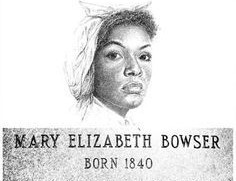
During the Civil War one of the most extensive and productive Union espionage networks was nestled in the heart of the capital of the Confederacy: Richmond, Virginia. At its helm was the unsuspecting socialite Elizabeth Van Lew – who deserves her own article. Van Lew had operatives spread through out the city including bakers, shopkeepers, slaves, servants, railway men and even Union prisoners of war. However, the majority of her critical intelligence quite probably came from one source; an operative that holds the distinction of being one of the highest placed Union spies during the Civil War. Her name was Mary Elizabeth Bowser.
Little is known about her, and the accounts that have survived vary. However, they all agree that working under a pseudonym, Mary Bowser secured employment as a servant for the Davis household, otherwise known as the Whitehouse of the Confederacy. Bowser passed herself off as a dim-witted but very able servant, and as such she was able to move about the Whitehouse with impunity. There was no effort taken to conceal documents or maps from her view since it was illegal to teach slaves to read or write in the South. Oh, right, forgot to mention that fact. Mary Bowser was African American.
She was an African American Union spy working in the Whitehouse of the Confederacy. Some might say that delivering fresh water to the soldiers at Gettysburg would have been a less dangerous post!
Mary Bowser was born into slavery and was the property of John Van Lew in Richmond, VA. After John’s death in 1843, his daughter Elizabeth convinced her mother that they should free all of their slaves, including Mary. Mary stayed on at the plantation as a paid servant where Elizabeth saw in her a keen intelligence and sent her to The Quaker School for Negroes in Philadelphia to be educated. Accounts vary as to what she did and where she went after her schooling. However, after the war broke out, Elizabeth enlisted her help and Mary became a spy. A job she was exceptionally suited for.
Not only could Mary Bowser secretly read and write she had a near photographic memory. Therefore, was able to recall not just correspondence that she had read, but entire conversations word for word. She passed on this information with ease to other members of Elizabeth’s network. The Davis’s knew that there was a leak in their household, but suspicion always fell away from Mary. It is unknown what finally shifted the focus onto Mary as the mole, but she was forced to flee Richmond in January of 1865 to avoid capture. How and where she lived out the rest of her life is unknown.
Unfortunately, the exact extent of Mary’s contributions to the fall of Richmond and the Confederacy has been lost. During reconstruction the Federal government destroyed almost all documentation pertaining to Union spies in an effort to protect those men and women in their post-war lives. It is said that Mary had kept a diary during her time as a spy, but family members inadvertently threw it away in the early 1950’s.
What little is known about her comes from the private documents and recorded recollections of spies that Mary Bowser interacted with, especially Elizabeth Van Lew and Thomas McNiven, a prominent baker who was part of Van Lew’s network. In 1995 the United States government formally acknowledged the value of Mary’s contribution when she was inducted into the U.S. Army Military Intelligence Corps Hall of Fame in Fort Huachuca, Arizona.
